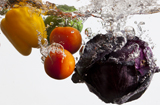Keep It Clean: Washing Fruits and Vegetables
While fruits and vegetables are essential to a healthy diet, they can become contaminated from manure, water, and animals or insects. If the leafy greens and juicy fruits are not cleaned properly, then foodborne illnesses can spread.
Use the following tips as a guide to washing specific produce groups.
Rinse and Rub
While their cleaning methods differ, be sure to rinse and rub the following fruits/vegetables for five seconds, and then re-rinse them.
Melons Before cutting the melons, wash them with cool water and scrub with a brush.
Citrus Fruits
Use a scrub brush and cool tap water to clean the fruit prior to peeling it.
Apples, Pears, Plums, Peaches, and Mangoes
Wash the fruits with cool water from the faucet, and then cut off the stem and blossom ends.
Small Fruits and Berries Put small fruits and berries into a colander and rinse with tap water—be sure to stir the berries around, so they all get an even wash, if needed.
Tomatoes, Cucumbers, and Peppers
Like with apples, scrub these fruits with cool tap water. Then, remove the stems and blossom ends.
Root Vegetables: Carrots, Potatoes, Turnips, and Radishes
These vegetables need to be scrubbed using cool water from the faucet until the visible dirt has been removed.
Soak and Rinse
Each of these vegetables should be soaked in tap water or with a mixture of a half cup of white distilled vinegar/lemon juice and two cups of water for two minutes. Be sure to rinse them off for 15 seconds after they’ve soaked.
Leafy Vegetables: Lettuces, Cabbages, Brussel Sprouts, Spinach, and Kale
Leafy vegetables can be a little trickier to clean, and they harbor the most foodborne illnesses.
Before washing the plant, remove its outer layers and then soak in the vinegar/lemon solution or in cool water. (If you see that your item is pre-washed, “washed,” or “ready-to-eat,” then it’s already been washed.)
Stem Vegetables: Asparagus, Celery, and Fennel
Use water or the vinegar/lemon solution to soak the vegetables. After they’ve been rinsed, remove the ends.
Floral Vegetables: Broccoli, Cauliflower, and Artichoke
Submerge these vegetables in a clean bowl, and drain them in a colander.
By properly washing your fruits and vegetables before eating them, you can diminish the chances of becoming sick from a foodborne illness.
Adapted and excerpted from:
E. Persaud, A. Simonne, and K. Shelnutt, “Home Gardening Food Safety: Washing the Fruits (and Vegetables) of Your Labor Properly” (FCS80032), UF/IFAS Family, Youth and Community Sciences Department (11/2013).

Related Sites & Articles
- Hot Topics
- Food Safety
- Food Safety: Potluck Parties
- Keep it Clean: Kitchen Sponges
- Keep It Clean: Washing Your Hands
- Washing Raw Foods
- UF/IFAS Publications
- Foodborne Illness

